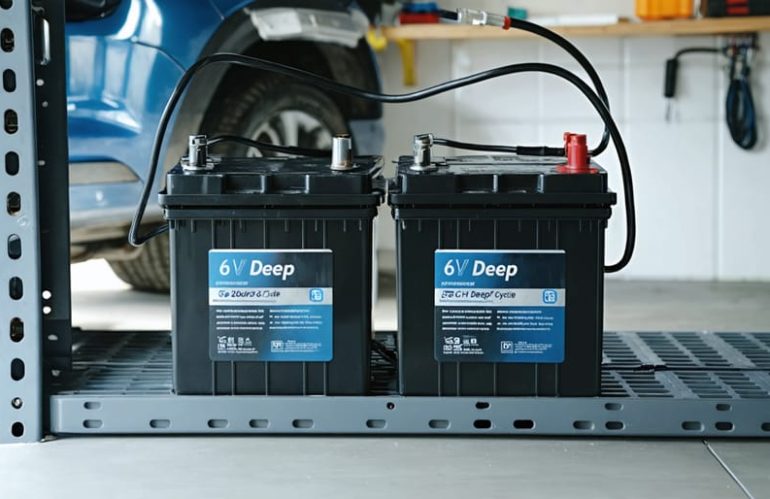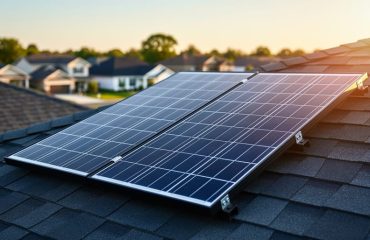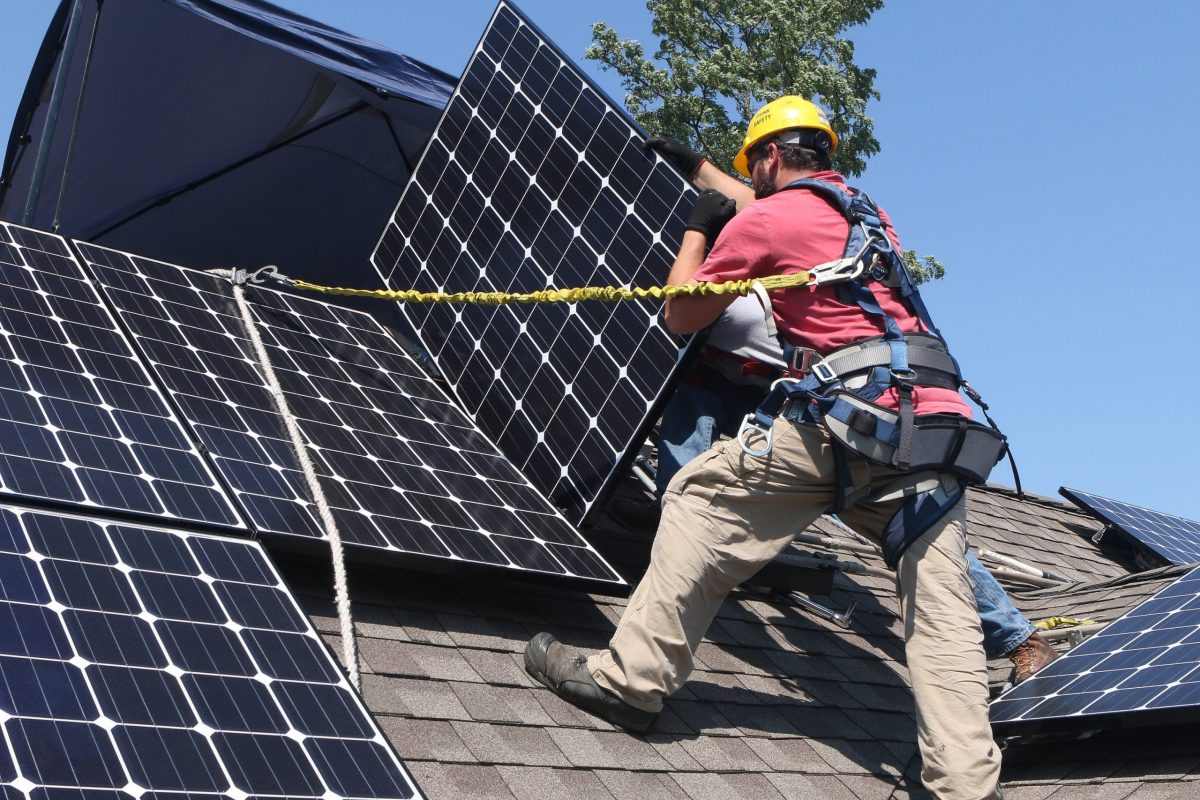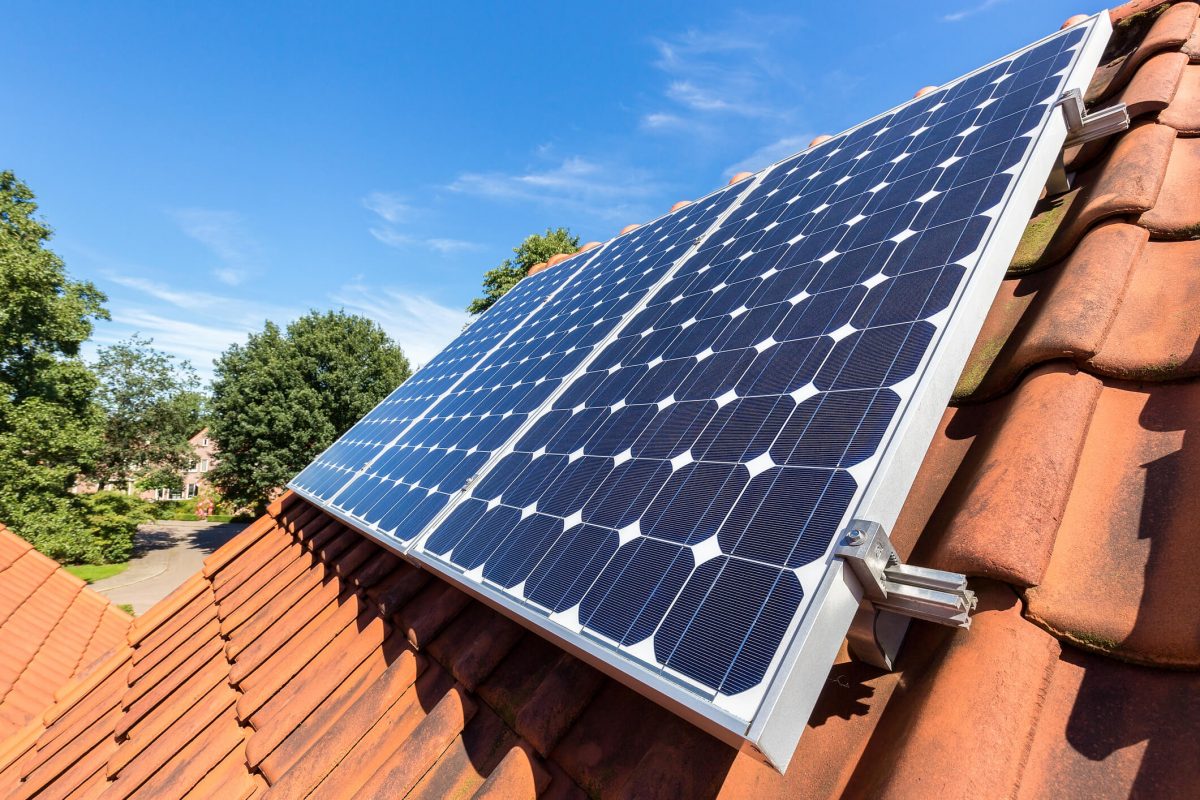Living near the coast brings unique challenges for solar energy storage, and 6V solar batteries offer a surprisingly practical solution that many seaside homeowners overlook. These compact powerhouses excel in salt air environments where corrosion and humidity threaten standard battery systems, delivering reliable energy storage without the complexity of larger alternatives.
Unlike their 12V counterparts, 6V batteries feature thicker internal plates that resist the accelerated degradation common in coastal climates. This design translates directly to longer lifespans—often 7-10 years compared to 3-5 years for conventional marine batteries—saving you money on replacements while maintaining consistent performance through storms and humid seasons.
The real advantage emerges when you wire multiple 6V units together in series to create robust marine solar systems. This configuration gives you flexibility to scale your storage capacity precisely to your home’s needs while maintaining the superior durability that coastal conditions demand. You’ll find these batteries simpler to transport and install than bulky alternatives, making future maintenance and expansions straightforward rather than overwhelming.
For homeowners committed to sustainable living near the water, 6V batteries represent the sweet spot between affordability, longevity, and environmental resilience—proving that effective solar storage doesn’t require industrial-scale equipment or complicated technical knowledge.
The Coastal Battery Problem Nobody Talks About

Salt Air Is Your Battery’s Worst Enemy
Salt-laden ocean air contains microscopic water droplets that settle on your battery terminals and metal components. When salt meets metal, it creates a chemical reaction that forms that crusty white or blue-green buildup you’ve probably noticed on old batteries. This corrosion acts like rust, eating away at the connections between your battery and solar system.
Here’s why this matters for your wallet: corroded terminals create resistance, which means your battery charges less efficiently and delivers less power to your home. Think of it like trying to drink a smoothie through a partially clogged straw—everything still works, but not nearly as well. Over time, severe corrosion can cause complete connection failure, forcing you to replace batteries years earlier than expected.
The good news? Understanding this enemy means you can fight back effectively. With proper protective measures—which we’ll cover shortly—your 6V solar batteries can thrive even steps from the shoreline. Coastal living doesn’t mean sacrificing battery longevity; it simply means being smart about maintenance and choosing the right protective strategies from day one.
Why Humidity Drains More Than Just Your Batteries
Coastal air carries more than just that refreshing ocean breeze—it’s loaded with moisture that can significantly shorten your solar battery’s lifespan. High humidity accelerates corrosion on battery terminals and internal components, creating a perfect environment for sulfation (those white, crusty deposits that reduce charging efficiency). In seaside environments, batteries can lose 20-30% of their expected lifespan without proper protection.
The good news? You’re not powerless against moisture damage. Regular terminal cleaning, proper ventilation in your battery enclosure, and applying a thin layer of dielectric grease creates an effective barrier. Some homeowners install silica gel packets near their batteries or invest in waterproof battery boxes designed specifically for marine conditions. These simple steps protect your investment and ensure your 6V solar batteries deliver reliable performance for years, even when living steps from the shore.
What Makes 6V Solar Batteries Different
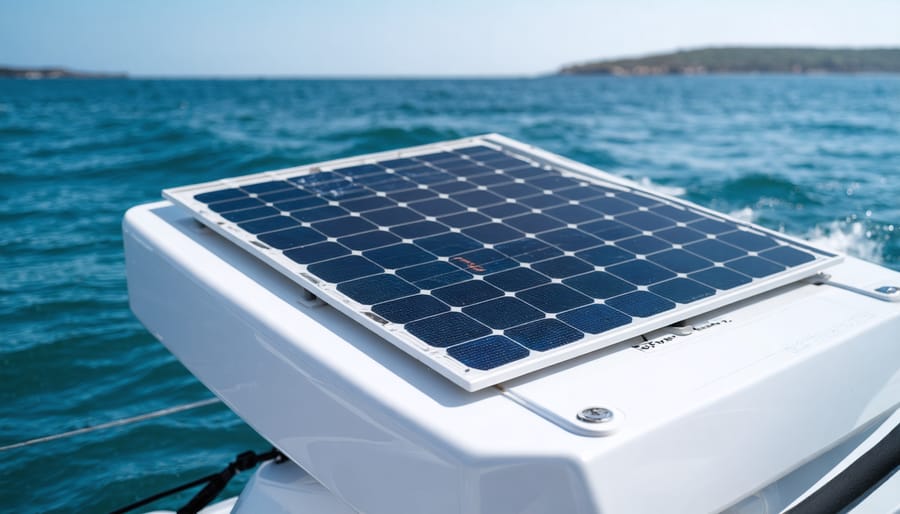
Thicker Plates Mean Longer Life
One of the biggest advantages of 6V solar batteries lies in their physical construction. These batteries feature thicker lead plates compared to their 12V counterparts, and this difference isn’t just a minor detail—it directly translates to a longer lifespan for your investment.
Think of it like comparing a heavy-duty cast iron skillet to a thin aluminum pan. The thicker construction simply holds up better over time, especially in demanding conditions like coastal environments where your batteries work harder due to temperature fluctuations and humidity.
These robust plates can withstand more charge and discharge cycles before showing wear, which means you’ll replace your batteries less frequently. For homeowners watching their long-term costs, this durability is a real money-saver. While the upfront cost might be slightly higher than standard batteries, you’re actually spending less per year of use.
In practical terms, quality 6V solar batteries with thick-plate construction can last 5-7 years or longer with proper maintenance, compared to 3-4 years for thinner alternatives. That’s potentially thousands of dollars saved over the lifetime of your solar system—money that stays in your pocket instead of going toward premature replacements.
Better Acid Stratification Resistance
In humid coastal areas, traditional batteries face a sneaky problem called acid stratification. This happens when the battery acid separates into layers—heavier acid sinks to the bottom while lighter liquid rises to the top. Think of it like oil and vinegar dressing that needs constant shaking. This separation causes uneven charging, reduces your battery’s lifespan, and can lead to premature failure.
Here’s the good news: 6V batteries naturally resist this chemical imbalance better than their 12V counterparts. Because they’re physically shorter, the acid has less vertical space to separate into distinct layers. It’s simple physics—less height means less opportunity for stratification to occur.
This advantage becomes particularly valuable in moisture-rich environments where batteries work harder and temperature fluctuations accelerate chemical processes. Just like harsh environment solar systems need specialized components, coastal installations benefit from batteries designed to handle challenging conditions. The result? Your 6V battery maintains more consistent performance throughout its life, meaning fewer replacements and better long-term value for your solar investment.
Real-World Performance in Marine Environments
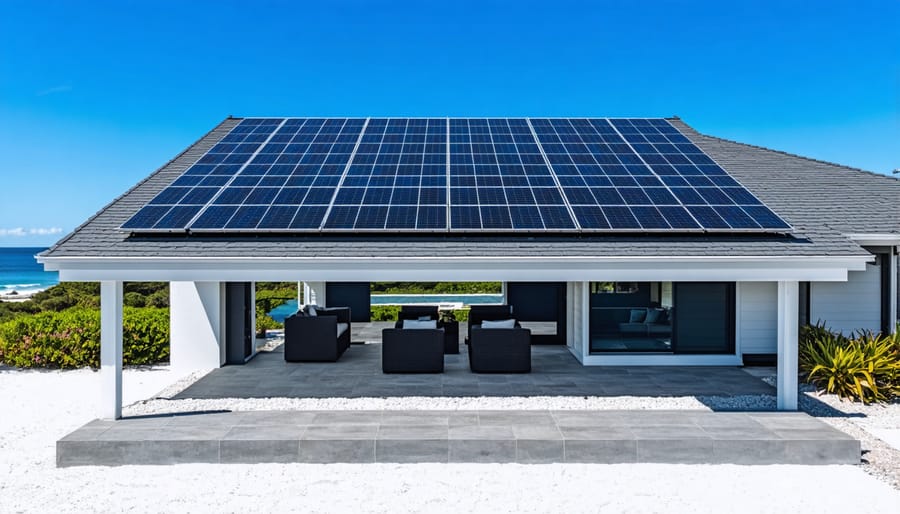
How They Handle Daily Ocean Fog
Here’s the reality: fog doesn’t stop your 6V solar batteries from working—it just slows them down temporarily. During those typical morning marine layers, your batteries continue charging at reduced rates, usually around 10-25% of full capacity. The good news? Your system is designed with this in mind.
Think of fog days like overcast weather anywhere else. Your batteries simply draw from stored energy during heavy fog periods, then recharge fully once the sun breaks through. Most coastal homeowners find that even with regular fog patterns, their 6V battery banks maintain adequate charge levels year-round.
The secret is proper system sizing. By adding one or two extra batteries to your setup, you create enough reserve power to handle those foggy mornings without any noticeable impact on your home’s energy supply. This small upfront investment means you won’t worry when you wake up to gray skies—your coffee maker will still work just fine.
Storm Season Reliability
When storm clouds roll in and the power grid goes down, 6V solar batteries prove their worth. These batteries excel at maintaining charge during extended periods of cloudy weather, storing enough energy to keep essential systems running when you need them most. Unlike the myth that solar setups fail during storms, quality 6V batteries actually shine in challenging conditions.
The secret lies in their deep-cycle design, which allows them to discharge slowly and consistently over several days without sunlight. This means your lights, refrigerator, and critical appliances stay operational during power outages—exactly when your neighbors might be scrambling for generators. Many coastal solar installations rely on 6V batteries specifically because they handle humidity and temperature fluctuations better than standard alternatives.
The financial peace of mind is significant too: you’re not paying premium prices for emergency generator fuel or dealing with spoiled food. Your 6V battery bank quietly does its job, keeping your home powered and your family comfortable through whatever weather comes your way.
The Lifespan Advantage You’ll Actually Notice
Quality 6V solar batteries typically last 5-7 years with proper maintenance—that’s about twice as long as conventional lead-acid batteries. What does this mean for your wallet? Instead of replacing batteries every 2-3 years at $300-500 per replacement, you’re looking at one replacement every six years. That’s potentially $1,000+ in savings over a decade.
Here’s the real kicker: this extended lifespan isn’t just about saving money on replacements. It also means fewer disposal headaches and less environmental impact—perfect if you’re committed to sustainable living. Most homeowners find their 6V batteries maintain 80% capacity even after five years of coastal use, meaning your solar system keeps performing reliably without the frustrating power drops that plague cheaper alternatives. Think of it as buying quality once instead of budget options repeatedly.
Setting Up Your 6V Battery System for Coastal Living
Series vs. Parallel: Which Setup Works Best
When connecting multiple 6V batteries for your coastal home’s solar system, you have two main options that are surprisingly straightforward. **Series connections** link batteries end-to-end (positive to negative), doubling your voltage—two 6V batteries in series give you 12V, which is what most home solar systems need. This setup is perfect for coastal homeowners who want standard voltage without complicated wiring.
**Parallel connections** join batteries side-by-side (positive to positive), keeping voltage at 6V while doubling your storage capacity. While this works for specialized applications, most coastal homes benefit more from series configurations since they match standard inverter requirements.
**The best practice for seaside properties?** Start with a simple series setup using two quality 6V batteries to create a 12V system. This gives you the voltage you need while keeping installation manageable. The beauty is you’re not locked in—you can always expand by adding another series pair in parallel later if your energy needs grow.
Don’t overthink it: series connections deliver the right voltage for most residential solar setups, require minimal technical know-how, and work beautifully in salty coastal environments when you choose batteries designed for marine conditions.
Protecting Your Investment from Salt Air
Salt air doesn’t have to be your battery’s enemy. With a few simple protective measures, your 6V solar batteries can thrive in coastal environments for years to come.
Start by choosing batteries with robust, corrosion-resistant casings designed for marine conditions. Once installed, apply a thin coating of petroleum jelly or specialized anti-corrosive spray to all terminals and connections—this creates a barrier against salt buildup. It takes just five minutes and can dramatically extend your system’s lifespan.
Keep your battery housing well-ventilated but protected from direct salt spray. A simple weatherproof enclosure with ventilation holes positioned away from prevailing winds works wonders. Check these vents quarterly to ensure they’re not blocked by debris or salt accumulation.
Regular rinsing is surprisingly effective. Every few months, gently spray down the exterior surfaces of your battery enclosure with fresh water to wash away salt deposits before they cause problems. Think of it like rinsing your car after a beach trip—preventive maintenance that saves money down the road.
Inspect connections every three months for signs of corrosion. White or green powdery buildup is your signal to clean terminals with a wire brush and baking soda solution, then reapply your protective coating. This quick check-up prevents small issues from becoming costly repairs.
These straightforward steps protect your investment without requiring technical expertise or expensive products. Most coastal homeowners find they can complete all maintenance tasks in under an hour per season—a small commitment for reliable, long-lasting solar power.
What This Means for Your Energy Bills
Let’s talk about what really matters to your wallet. When you choose 6V solar batteries for your coastal home, you’re making a smart financial decision that pays off in multiple ways.
First, the longevity factor. Thanks to their superior corrosion resistance in salty air, 6V batteries typically last 7-10 years in coastal environments—that’s 2-3 years longer than standard batteries in the same conditions. Fewer replacements mean your money stays in your pocket instead of going toward emergency battery purchases every few years.
The performance advantage translates directly to savings too. Because 6V batteries maintain their efficiency better in humid, salt-laden conditions, you’ll extract more usable power from your solar investment. This means less reliance on grid electricity during cloudy periods or high-demand times. Homeowners often report 15-20% better energy retention compared to less robust alternatives, which can shave $200-400 off annual electricity bills depending on your system size.
Here’s another often-overlooked benefit: predictable maintenance costs. Unlike batteries that degrade quickly in coastal conditions, 6V batteries provide consistent performance throughout their lifespan. You won’t face those frustrating surprise expenses when a battery fails prematurely. Just like extreme climate solar solutions designed for harsh environments, 6V batteries are built to handle challenging conditions reliably.
The upfront cost might be slightly higher—typically $50-100 more per battery—but when you calculate the extended lifespan and improved efficiency, you’re looking at saving $500-800 over the battery’s lifetime. That’s real money back in your hands for other home improvements or simply enjoying your seaside lifestyle.
Common Myths About Marine-Climate Solar Batteries
“Solar Doesn’t Work Well Near the Ocean”
You might have heard that salty sea air ruins solar equipment, but that’s outdated information. Modern 6V solar batteries are designed with corrosion-resistant terminals and sealed construction that protects against coastal moisture. The truth is, coastal areas often receive excellent sun exposure, making them ideal for solar energy. The key is choosing quality batteries with marine-grade components and proper protective housing. Many beachfront homes successfully run solar systems year-round without issues. Regular maintenance—like wiping down terminals and ensuring connections stay dry—takes just minutes and prevents problems. Your oceanside location isn’t a disadvantage; with the right setup, it’s actually perfect for capturing abundant solar energy and reducing those high coastal utility bills.
“All Deep-Cycle Batteries Are the Same”
Here’s a common misconception: all deep-cycle batteries deliver the same performance regardless of voltage configuration. In reality, 6V batteries offer distinct advantages that make them particularly well-suited for coastal solar systems. Unlike their 12V counterparts, 6V batteries feature thicker lead plates, which means they can handle deeper discharge cycles without degrading—essential when dealing with inconsistent weather patterns common in seaside locations. This design also makes them more resistant to the sulfation damage that salt air accelerates. When you connect two 6V batteries in series to create a 12V system, you’re essentially getting double the plate thickness and durability of a single 12V battery. The result? Your battery bank lasts longer and performs more reliably in challenging marine environments, saving you money on replacements while ensuring your solar system keeps running smoothly through coastal conditions.
For coastal homeowners ready to embrace clean energy, 6V solar batteries offer a winning combination of reliability and cost-effectiveness. These compact powerhouses stand up beautifully to salty air and humid conditions while delivering consistent performance year after year. By choosing 6V batteries for your solar setup, you’re not just protecting the ocean views you love—you’re actively reducing your carbon footprint and slashing those monthly utility bills.
The financial benefits speak for themselves: lower maintenance costs, extended battery life in marine environments, and significant energy savings that add up over time. Plus, you’ll enjoy the peace of mind that comes with a proven technology designed specifically for challenging coastal conditions.
While many homeowners successfully install their own solar battery systems, working with a qualified professional ensures optimal performance and longevity. A certified installer can assess your specific needs, recommend the right battery configuration, and guarantee your system meets local codes—giving you the confidence to enjoy worry-free renewable energy for decades to come.

